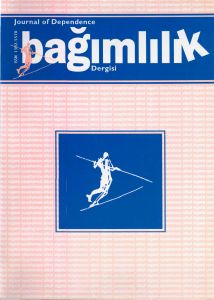Peer characteristics and substance use among high school students
Keywords:
Substance use, peer characteristics, peer influence, risk factors, adolescence, genderAbstract
Objective: The goals of this study are to determine peer characteristics of high school students and evaluate environmental factors that increase their risk of substance use. In addition to that, it is aimed to display peer characteristics of substance users.
Method: As a scope of Youth Research, 43 schools were randomly selected among 15 districts of İstanbul. 3842 questionnaires were administered to 10th grade students between March – May 2004. 3168 questionnaires were valid. In this article, questionnaires sections regarding peer characteristics and substance use are evaluated.
Results: It has been found that lifetime prevalence of tobacco and alcohol use are %34.3 and %49.7 respectively, and of any other substance use is %14.3. Among peer characteristics that increase the risk of substance use, having a drug-user peer is found to be prominent. Those who have substance user friends are at 6 times higher risk of using drugs. In addition to that, compared to girls, boys are at 2.5 times more risk of having friends who engage in trouble with police and theft and 2 times more likely to have friends that intentionally damage other people’s property. But risk of having antisocial peers is higher for substance user girls, than boys. For instance, girls who stated that they have used drugs are 6.6 times higher at risk of having friends committing theft whereas this risk is at 3.3 times for boys. %50.2 of substance users have substance user peers whereas %15.2 of non-users do so.
Conclusion: For purpose of making detailed analysis of peer influence, this study should be replicated taking into account the structure of risky peer group. Peer influence as a risk factor should be re-evaluated by making gender based comparisons.
References
Ögel K, Çorapçıoğlu A, Sır A, ve ark. Dokuz ilde ilk ve ortaöğretim öğrencilerinde tütün, alkol ve madde kullanım yaygınlığı. Türk Psikiyatri Dergisi 2004; 15: 112-118.
Ögel K, Tamar D, Evren C, Çakmak D. Lise gençleri arasında sigara, alkol ve madde kullanım yaygınlığı. Türk Psikiyatri Dergisi 2001; 12: 47–52.
Van den Bree MBM, Pickworth WB. Risk factors predicting changes in marijuana involvement in teenagers. Arch Gen Psychiatry 2005; 62: 311-319.
Brook JS, Brook DW, Arencibia-Mireles O, et al. Risk factors for adolescent marijuana use across cultures and across time. J Genet Psychol. 2001; 162: 357-374.
Dishion TJ. Cross–setting consistency in early adolescent psychopathology: deviant friendships and problem behavior sequelae. J Pers. 2000; 68: 1109–1126.
Svensson R. Risk factors for different dimensions of adolescent drug use. Journal of Child & Adolescent Substance Abuse 2000; 9: 67-90.
Crosby R, Salazar RF, DiClemente, RJ, et al. Health risk factors among adolescent females. Am J Prev Med. 2004; 27: 404–410.
La Greca AM, Prinstein MJ, Fetter MD. Adolescent peer crowd affiliation: linkages with health risk behaviors and close friendships. J Pediatr Psychol. 2001; 26: 131143.
Lindberg LD, Boggess S, Williams S. Multiple threats: the co-occurance of teen health risk behaviors, Urban Institute, Office of the Assistant Secretary for Planning and Evaluation (ASPE), 2000.
Mason WA, Windle M. Reciprocal relations between adolescent substance use and delinquency. J Abnorm Psychol. 2002; 111: 63–76.
Springer JF, Sale E, Hermann J, et al. Characteristics of effective substance abuse prevention programs for highrisk youth. The Journal of Primary Prevention. 2004; 25: 171-219.
Tot S, Yazıcı K, Yazıcı A, ve ark. Psychosocial correlates of substance use among adolescents in Mersin, Turkey. Public Health. 2004; 118: 588-593.
Friedman AS, Glassman K. Family risk factors versus peer risk factors for drug abuse, A longitudinal study of an African American urban community sample. J Subst Abuse Treat. 2000; 18: 267-275.
Gilvarry E. Substance abuse in young people. J Child Psychol Psychiatry. 2000; 41: 55–80.
Yang M-S, Yang M-J, Liu Y-H, Ko Y-C. Prevelance and related risk factors of licit and illicit substances use by adolescent students in Southern Taiwan. Public Health. 1998; 112: 347-352.
Prinstein MJ, Boergers J, Spirito A. Adolescents’ and their friends’ health risk behavior: factor that alter or add to peer influence. J Pediatr Psychol. 2001; 26: 287-298.
Fergusson DM, Swain–Campbell NR, Horwood LJ. Deviant peer affiliations, crime and substance use: a fixed effects regression analysis. J Abnorm Psychol. 2002; 30: 419–430.
Svensson R. Gender differences in adolescent drug use: the impact of parental monitoring and peer deviance.
Santor DA, Messervey D, Kusumakar V. Measuring peer pressure, popularity, and conformity in adolescent boys and girls: predicting school performance, sexual attitudes, and substance abuse Journal of Youth and Adolescence 2000; 29: 163-183.
Ögel K, Eke C, Taner S, Erol B. İstanbul’da öğrencilerde riskli davranışlar araştırması. Yeniden Yayın No: 6, İstanbul, 2004. MEB http://apk.meb.gov.tr/ Birimler/ Istatis-tikDairesiBaskanligi/ Dosyalar/ 2003-2004 Milli Egitim Sayısal Veriler.zip.
Hibell B, Anderson B, Bjarnason T. The ESPAD Report: Alcohol and other drug use among students in 26 European countries. The Swedish Council for information on alcohol and other drugs, Stockholm, Sweden: CAN, 1995.
Ercan O, Alikaşifoğlu M, Erginöz E, ve ark. İstanbul lise gençlerinde riskli davranışların sıklığı ve cinsiyete göre dağılımı (Cerrahpaşa Gençlik Sağlığı Araştırması 2000) Türk Pediatri Arşivi 2001; 36: 199-211.
Tamar D, Ögel K, Evren C, Çakmak D. Ergenlik döneminde madde kullanımı. Ege Psikiyatri Sürekli Yayınları 1997; 4: 501-517.
Downloads
Published
Issue
Section
License
Copyright (c) 2025 Journal of Dependence

This work is licensed under a Creative Commons Attribution-NonCommercial-NoDerivatives 4.0 International License.
The Journal and content of this website is licensed under the terms of the Creative Commons Attribution-NonCommercial-NoDerivatives 4.0 International (CC BY-NC-ND 4.0) License. This is in accordance with the Budapest Open Access Initiative (BOAI) definition of open access. The Creative Commons Attribution-NonCommercial-NoDerivatives 4.0 International (CC BY-NC-ND 4.0) allows users to copy, distribute and transmit unmodified article, and make noncommercial use of the article. The CC BY license permits non-commercial re-use of an open access article, as long as the author is properly attributed.

